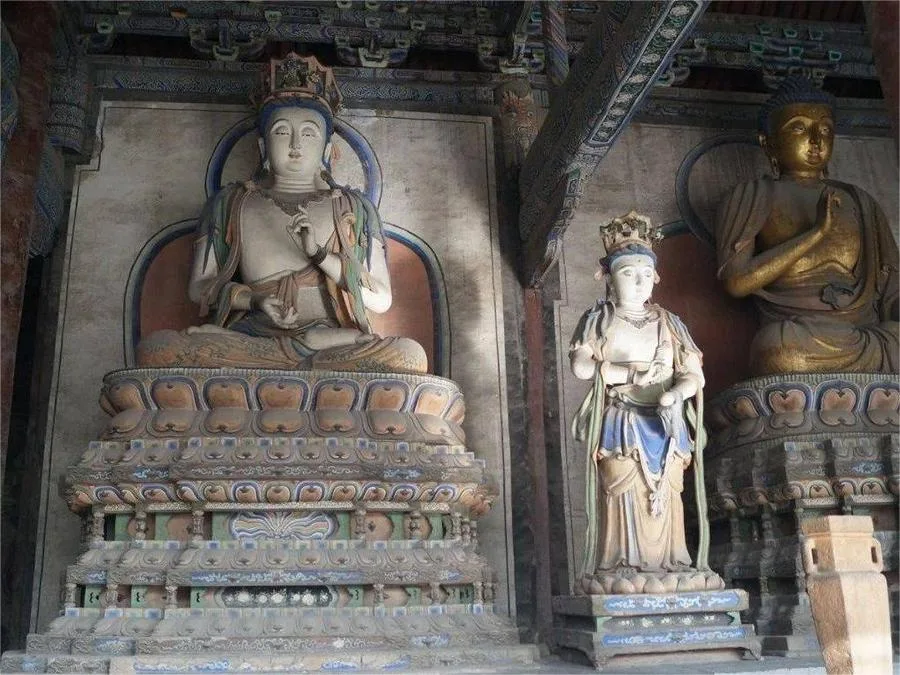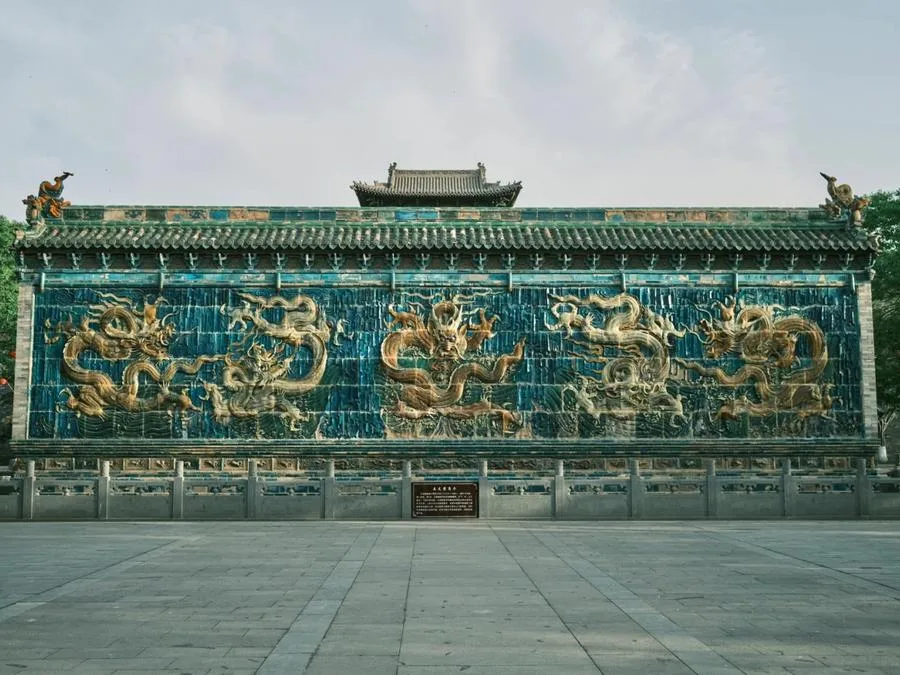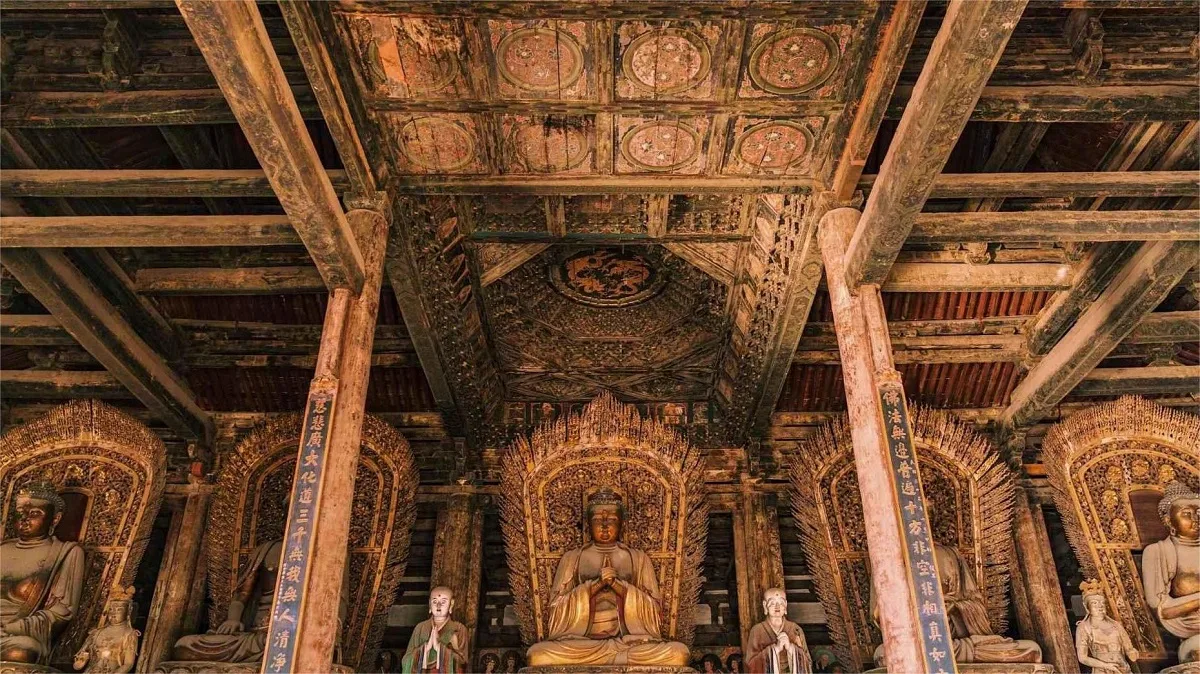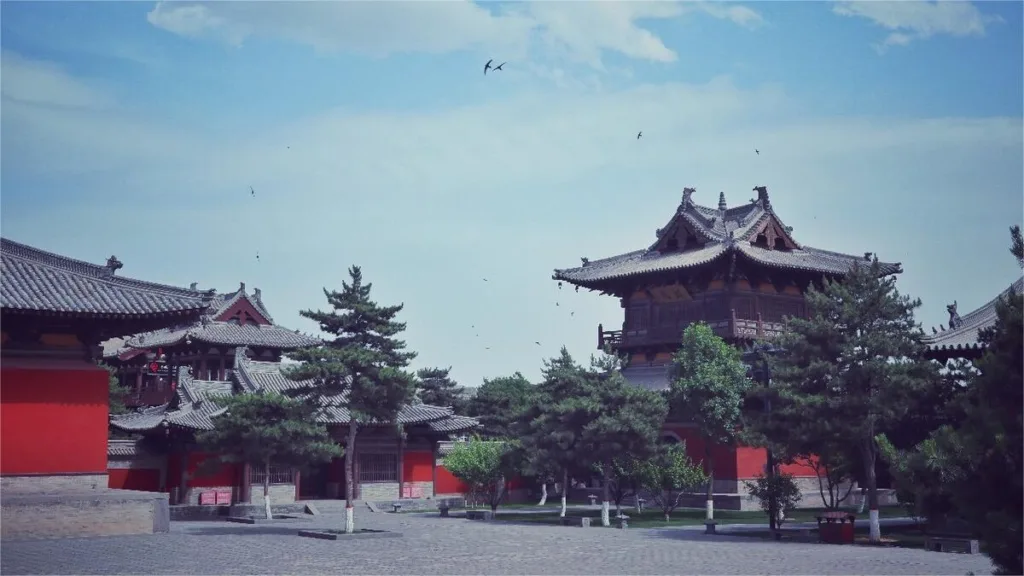Shanhua Temple (善化寺), commonly known as the Southern Temple (南寺), was originally built during the Kaiyuan period of the Tang Dynasty and was then known as Kaiyuan Temple. During the Later Jin Dynasty of the Five Dynasties period, it was renamed Dapu‘en Temple (大普恩寺). The temple underwent significant reconstruction under the supervision of Monk Yuanman during the Jin Dynasty. In the 10th year of the Zhengtong reign (1445) of the Ming Dynasty, Emperor Yingzong bestowed upon it the name Shanhua Temple, which has been used ever since.
Shanhua Temple is the largest and most complete surviving architectural complex from the Liao and Jin periods in China. Its main buildings are arranged along a central axis, facing south and progressively increasing in height. At the front is the Shanmen (Mountain Gate), followed by the Sansheng Hall (Three Saints Hall), both constructed during the Jin Dynasty. The Mahavira Hall from the Liao Dynasty is located on a high platform at the rear, flanked by the East and West Wing Halls. To the east lies the site of the Shuge Pavilion, and to the west stands the Puxian Pavilion, built in the second year of the Jin Zhenyuan reign (1154).
Apart from the Liao and Jin period buildings like the Shanmen, Sansheng Hall, Daxiong Baodian, and Puxian Pavilion, the temple also houses auxiliary halls and bell and drum towers from the Ming and Qing periods. Inside the temple, there are 34 Jin Dynasty statues, 190 square meters of Qing Dynasty murals, nine Ming Dynasty statues, two Jin Dynasty steles, and three steles from the Ming and Qing restorations. Although the Five-Dragon Screen within the temple is smaller than the famous Nine-Dragon Screen in Datong, it is still exquisitely crafted and worth seeing.
Table of Contents
- Basic Information
- Location and Transportation
- Highlights of Shanhua Temple
- Vlog about Shanhua Temple
- Other Attractions in Datong Ancient City
Basic Information
| Estimated Length of Tour | 1 hour |
| Ticket Price | Free |
| Opening Hours | 8.30 – 17.00 |
| Telephone Number | 0086-0352-2539436 |
Location and Transportation
Shanhua Temple is located at 6 Nansi Street, Datong Ancient City, Pingcheng District, Datong City, Shanxi Province, near Loufang Alley. To get there, you can take bus 35 and get off at Yongtai West Gate Stop (永泰西门站).
Highlights of Shanhua Temple
Mahavira Hall

The Mahavira Hall is the largest hall in Shanhua Temple, featuring an expansive courtyard and flanked by bell and drum towers on either side. The hall measures 40.7 meters in width and 25.5 meters in depth, with a single-eave, five-ridge roof. As a Liao Dynasty structure, its 1,200-square-meter area makes it the third-largest single-structure Liao building in China.
Inside the hall, the central feature is the array of five Buddha statues, known as the Five Directional Buddhas. From east to west, they are Akshobhya Buddha, Ratnasambhava Buddha, Vairocana Buddha, Amitabha Buddha, and Amoghasiddhi Buddha. These statues are notable for their dignified and elegant expressions, with smooth flowing robes. Below the lotus thrones stand disciples and bodhisattvas, which are original Liao and Jin period creations. The east and west sides of the hall house statues of the Twenty-Four Heavenly Beings, each with distinct and vivid expressions. Additionally, the western and southern walls feature murals dating from the 25th to 47th year of the Kangxi reign (1686–1708) in the Qing Dynasty, depicting various Buddhist stories.
Sansheng Hall (Hall of Three Saints)

The Sansheng Hall is centrally located within the temple complex and stands on a brick platform approximately 1.5 meters high. The hall is five bays wide and four bays deep, with a single-eave hipped roof. The eaves are supported by an intricate bracket system, featuring a single cantilever with double under-ang supports. The interior employs a pillar-reducing technique to enhance space utilization.
The main altar inside the Sansheng Hall houses the Huayan Three Saints, which are original Jin Dynasty sculptures later refurbished. The hall also contains two Jin Dynasty steles on either side, with one dating back to the 16th year of the Dading reign (1176), known as the “Record of the Reconstruction of the Main Hall of Dapuen Temple in Western Capital of the Great Jin.” This stele was authored by Zhu Bian, the deputy envoy from the Southern Song Dynasty to the Jin Dynasty.
Other Historical Buildings

Tianwang Hall (Heavenly Kings Hall): Currently serving as the main gate, Tianwang Hall is the largest surviving gate from the Jin Dynasty in China. It spans five bays in width and two bays in depth, featuring a single-eave hipped roof. The hall houses the Ming Dynasty statues of the Four Heavenly Kings, each with an imposing and fierce expression, reflecting their protective role in Buddhist cosmology.
Puxian Pavilion: Located between the Daxiong Baodian and Sansheng Hall on the western side, Puxian Pavilion is a tower-like structure with a square layout. It measures three bays in both width and depth and has a double-eave, nine-ridge roof. The pavilion was reconstructed in the second year of the Jin Zhenyuan reign (1154).
Colorful Clay Sculptures

The temple preserves 34 Jin Dynasty statues and nine Ming Dynasty statues. The Jin Dynasty clay sculptures narrate a story centered around “Hariti,” a tale from Buddhist scriptures. According to the scriptures, Hariti was originally a shepherd girl who participated in a celebration in Rajgir while pregnant. In her excitement, she miscarried, and the people shunned her. In her fury, she swore to be reborn in Rajgir and devour children. In her next life, she was born in Rajgir, bore 500 children, and began eating the city’s infants. Eventually, the Buddha enlightened and admonished her, leading her to repent and convert to Buddhism.
A notable feature in these sculptures is the depiction of a small demon girl with a green face and red hair under Hariti’s left foot, representing her malicious nature before her conversion. The artist skillfully contrasts her evil past with her transformed, benevolent appearance, highlighting her redemption.
Five-Dragon Screen

The Five-Dragon Screen, originally from Xingguo Temple in southern Datong, was relocated in 1980 to stand before Shanhua Temple. This magnificent screen measures 19.9 meters in length and 7 meters in height, adorned with colorful glazed tiles. It features five grand dragons intricately carved in relief, twisting and turning in dynamic poses. The craftsmanship is exquisite, with detailed attention to the dragons’ claws, eyes, eyelashes, whiskers, and manes, exuding an aura of power and majesty befitting their status as mythical kings.
Zhu Bian Stele

Among the notable steles at Shanhua Temple are two from the Jin Dynasty and three from the Ming and Qing dynasties. The most famous is the stele known as the “Zhu Bian Stele” or “Jin Stele,” written by the talented Southern Song scholar Zhu Bian. Erected in the 16th year of the Dading reign (1176), it details the reconstruction of the temple after its destruction at the end of the Liao Dynasty. The stele stands 4.45 meters tall and 1.28 meters wide, featuring 1,076 characters inscribed in the Yan style. This stele is the earliest written record of Shanhua Temple, providing invaluable historical insight into its past.
Zhu Bian, a notable Southern Song scholar from Wuyuan in Huizhou (1085-1144), was the great uncle of the famous Neo-Confucian philosopher Zhu Xi. According to the “History of Song,” in the first year of Jianyan (1127), Emperor Gaozong of Song sought envoys to inquire about the whereabouts of the captured emperors Huizong and Qinzong. Wang Lun was appointed as the chief envoy, and Zhu Bian volunteered to be the deputy envoy. In January of the following year, Wang Lun, Zhu Bian, and their party braved the snow to reach Datong, the Western Capital of the Jin Dynasty.
Zhu Bian was detained in Datong for 17 years, spending 14 of those years residing at Dapuen Temple. During his stay, he developed a deep bond with the monks of the temple, especially with Master Yuanman, who tirelessly worked to restore the temple despite his advanced age. Zhu Bian witnessed these efforts firsthand and penned the stele inscription “Record of the Reconstruction of the Great Hall of Dapuen Temple in the Jin Western Capital.” This stele, now standing for over 800 years, is regarded as a “treasure of the temple.”








